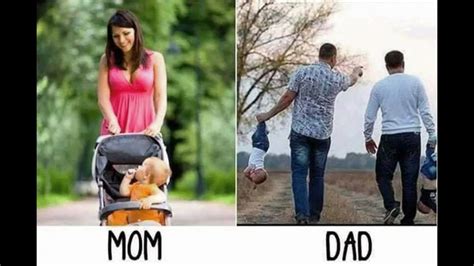
A golden retriever named Denver is charming the internet with his dramatically different behavior towards his “mom” versus his “dad,” as showcased in a viral video highlighting the dog’s hilariously contrasting interactions. The video, posted to TikTok by user @DenverTheGolden, has garnered millions of views and showcases Denver’s submissive, gentle demeanor with his female owner compared to his playful, mischievous antics with his male owner.
The viral video, capturing Denver’s polar opposite behaviors, opens with the text overlay: “Dog’s double life: Mom vs. Dad.” The split-screen then reveals the vast differences in how Denver acts depending on which owner is present. With his “mom,” Denver is the epitome of a well-behaved dog, calmly sitting, offering gentle licks, and responding obediently to commands. In stark contrast, when his “dad” is around, Denver transforms into a playful rascal, engaging in mock wrestling, playfully nipping, and generally exhibiting a more energetic and boisterous attitude.
“It’s like he’s two completely different dogs,” commented one user on the TikTok video, echoing the sentiments of many viewers who found Denver’s dual personality both amusing and relatable. The video has sparked a wide range of reactions, with many dog owners sharing their own experiences of their pets behaving differently depending on who is in charge.
The video’s popularity underscores a common phenomenon in pet ownership: dogs often form distinct relationships with different members of their human families, adapting their behavior based on individual interactions and perceived roles within the household. Experts suggest that this behavior can be influenced by a variety of factors, including differences in training styles, play patterns, and even the tone of voice used by each owner.
Denver’s case, however, appears to be particularly pronounced, leading to widespread amusement and speculation about the reasons behind his marked behavioral differences. Whether it’s a conscious adaptation or simply a reflection of the different energies within the household, Denver’s “double life” has resonated with dog lovers across the internet, providing a lighthearted glimpse into the complex social dynamics that can exist between humans and their canine companions.
The video serves as a reminder of the unique bond that humans share with their pets and the fascinating ways in which animals navigate their social worlds. Denver, the golden retriever, has become a viral sensation, proving that even the most ordinary moments can be extraordinary when viewed through the lens of interspecies connection and comedic contrast.
Denver’s owner, speaking to Yahoo Life, stated, “He knows he can get away with more with Dad. Mom is the disciplinarian.” This simple explanation seems to encapsulate the dynamic perfectly, highlighting the role of each owner in shaping Denver’s behavior. The “mom” provides structure and expects obedience, while the “dad” is perceived as a playmate, creating an environment where Denver feels comfortable letting loose.
The video further exemplifies how pets can perceive and respond to the subtleties of human behavior, understanding the nuances of each individual’s personality and adapting their own conduct accordingly. This level of social intelligence is a testament to the deep connection between humans and animals, and it’s precisely what makes Denver’s “double life” so captivating.
In-Depth Analysis of Denver’s Behavior
Denver’s contrasting behavior raises several interesting questions about canine psychology and the human-animal bond. Experts in animal behavior suggest that multiple factors could contribute to Denver’s distinct interactions with his mom and dad.
One key factor is the concept of differential reinforcement, which refers to the process by which different behaviors are reinforced (or punished) by different individuals. In Denver’s case, it’s likely that his “mom” reinforces calm, obedient behavior with praise, treats, or affection, while discouraging rambunctious play. Conversely, his “dad” may inadvertently reinforce playful behavior by engaging in it and finding it amusing. This creates a situation where Denver learns that different behaviors are appropriate (and rewarded) depending on which owner is present.
Another factor to consider is the role each owner plays in the dog’s life. The “mom” may be primarily responsible for tasks such as feeding, grooming, and training, which can establish her as the authority figure in Denver’s eyes. The “dad,” on the other hand, may be more involved in playtime and recreational activities, leading Denver to associate him with fun and relaxation. This distinction in roles can contribute to the different behavioral patterns observed in the video.
Body language and communication styles also play a crucial role. Dogs are highly attuned to human body language, and they can pick up on subtle cues that indicate whether a person is open to play or prefers a more subdued interaction. Denver may be interpreting his “mom’s” body language as a signal to be calm and respectful, while perceiving his “dad’s” body language as an invitation to engage in playful antics.
Furthermore, the dog’s personality itself cannot be overlooked. Every dog has a unique temperament and set of preferences, and some dogs may simply be more inclined to be playful and energetic than others. It’s possible that Denver is naturally a playful dog, but he has learned to suppress this aspect of his personality when he’s around his “mom” because he knows that she prefers a calmer demeanor.
The video also highlights the importance of consistency in training and expectations. If the “mom” and “dad” have different rules and expectations for Denver’s behavior, it can lead to confusion and inconsistency. While Denver seems to have adapted well to this situation, it’s important for all members of a household to be on the same page when it comes to training and discipline to avoid creating mixed signals for the dog.
Finally, it’s crucial to acknowledge the possibility of learned associations. Denver might have, over time, associated certain activities or routines with each parent. For example, if the “dad” always initiates walks or playtime, Denver might become overly excited and playful in anticipation of those activities. These learned associations can solidify the contrasting behaviors observed in the video.
The Broader Context: Dogs and Human Families
Denver’s story is not unique. Many dog owners report that their pets behave differently depending on who they are interacting with. This phenomenon reflects the complex social dynamics that exist within human families and the remarkable ability of dogs to adapt to different social environments.
Dogs have evolved alongside humans for thousands of years, and they have developed a keen understanding of human behavior and social cues. They are highly social animals, and they form strong bonds with their human families. Within these families, dogs often establish a hierarchy of sorts, identifying different individuals as authority figures, playmates, or sources of comfort.
The way a dog interacts with each family member can be influenced by a variety of factors, including the individual’s personality, their role in the dog’s life, and the type of interactions they typically engage in. Some dogs may be more attached to one particular family member, while others may distribute their affection more evenly.
Understanding these dynamics is essential for creating a harmonious and fulfilling relationship with your dog. By recognizing the different roles that each family member plays in the dog’s life and by being consistent in your training and expectations, you can help your dog feel secure, loved, and well-adjusted.
Denver’s viral video serves as a lighthearted reminder of the complex and fascinating ways in which dogs navigate their social worlds. It also highlights the importance of understanding canine behavior and the remarkable bond that humans share with their canine companions. His “double life” is not a sign of deception, but rather a testament to his intelligence, adaptability, and his ability to form unique relationships with each member of his family.
The Impact of Social Media on Pet Culture
The popularity of Denver’s video also speaks to the growing role of social media in shaping pet culture. Platforms like TikTok, Instagram, and YouTube have become hubs for sharing adorable pet videos, connecting with other pet owners, and learning about animal behavior and care.
The internet has democratized pet ownership advice and information, allowing owners to access a wealth of resources from experts and fellow enthusiasts. Social media has also created a platform for celebrating the unique personalities and quirks of our pets, fostering a sense of community and connection among pet lovers around the world.
However, it’s also important to be critical of the information you find online and to consult with qualified professionals when making decisions about your pet’s health and well-being. Not all pet-related content on social media is accurate or reliable, and it’s crucial to discern credible sources from those that are not.
Despite these challenges, social media has undoubtedly had a positive impact on pet culture, raising awareness about animal welfare issues, promoting responsible pet ownership, and celebrating the joy and companionship that pets bring to our lives. Denver’s viral video is a prime example of how social media can amplify the stories of our beloved pets and connect us with a global community of animal lovers.
The Science Behind Canine Behavior
The study of canine behavior is a complex and multifaceted field that draws upon insights from biology, psychology, and ethology (the study of animal behavior). Researchers are constantly learning more about the cognitive abilities, social behavior, and emotional lives of dogs.
One key area of research focuses on understanding how dogs perceive and interpret human communication. Studies have shown that dogs are capable of understanding a wide range of human gestures, facial expressions, and vocal cues. They can even learn to associate specific words with objects, actions, or concepts.
Another area of research explores the genetic basis of canine behavior. By studying the DNA of different dog breeds, researchers are beginning to identify genes that are associated with specific behavioral traits, such as aggression, trainability, and sociability.
Understanding the science behind canine behavior is essential for developing effective training methods, addressing behavioral problems, and improving the welfare of dogs. By applying scientific principles to our interactions with dogs, we can create stronger and more fulfilling relationships with our canine companions.
Denver’s “double life,” while seemingly humorous, provides a real-world example of many principles studied in canine behavior research. His ability to differentiate between his owners and adapt his behavior accordingly is a testament to the intelligence and adaptability of dogs.
Responsible Pet Ownership: A Lifelong Commitment
Owning a pet is a significant responsibility that requires a lifelong commitment to providing for the animal’s physical and emotional needs. Before bringing a dog into your home, it’s important to carefully consider whether you have the time, resources, and lifestyle to provide a happy and healthy life for the animal.
Responsible pet ownership includes providing proper nutrition, regular veterinary care, adequate exercise, and consistent training. It also means creating a safe and stimulating environment for your dog and socializing them with other animals and people.
Adopting a dog is a wonderful way to give a deserving animal a loving home. When adopting, it’s important to choose a dog that is a good fit for your lifestyle and to be prepared to provide the animal with the care and attention it needs to thrive.
It’s also essential to be aware of local animal welfare laws and regulations and to comply with all requirements related to pet ownership. This may include licensing your dog, vaccinating them against rabies, and keeping them under control in public places.
By embracing responsible pet ownership practices, you can ensure that your dog enjoys a long, happy, and fulfilling life. And in return, you will receive the unconditional love, loyalty, and companionship that only a dog can provide.
Denver, with his viral “double life,” reminds us of the unique personalities and quirks that make each dog special. By understanding and appreciating these individual differences, we can build stronger and more meaningful relationships with our canine companions.
Conclusion
Denver’s amusing dichotomy highlights the intricate relationships dogs form with different members of their human families. His ability to differentiate between his “mom” and “dad” and adjust his behavior accordingly demonstrates the impressive social intelligence of dogs. The viral video has resonated with millions, sparking conversations about pet behavior, the human-animal bond, and the role of social media in shaping pet culture. While Denver’s behavior is entertaining, it also offers valuable insights into canine psychology and the importance of responsible pet ownership. By understanding the factors that influence canine behavior and by providing our pets with love, care, and consistent training, we can foster strong and fulfilling relationships with these amazing animals. The golden retriever’s case demonstrates that dogs are not simply pets, but rather integral members of our families, each contributing their unique personality and charm to our lives. The video has also amplified the importance of understanding the specific needs and temperaments of different dog breeds, as golden retrievers are known for their friendly and adaptable nature.
Frequently Asked Questions (FAQ)
1. Why does my dog behave differently with different people?
Dogs are highly social animals capable of forming distinct relationships with different individuals. Factors influencing this behavior include differential reinforcement (different people rewarding different behaviors), perceived roles (who feeds, trains, plays), communication styles, and the dog’s individual personality. As Denver’s case shows, dogs can quickly learn what behaviors are acceptable and rewarded by each person.
2. Is it normal for a dog to be more obedient with one person than another?
Yes, it is entirely normal. This often stems from consistency in training and the perceived authority figure. If one person consistently enforces rules and provides clear commands, the dog is likely to be more obedient with them. If another person is more lenient or playful, the dog may exhibit less obedience.
3. How can I ensure my dog behaves consistently with everyone?
Consistency is key. All members of the household should agree on training methods, rules, and commands. Attend training sessions together so everyone uses the same cues. Ensure everyone provides the same level of positive reinforcement for desired behaviors. Regular training sessions can help reinforce consistent expectations.
4. Should I be concerned if my dog is more aggressive with one person than another?
If your dog exhibits aggressive behavior (growling, snapping, biting) towards a specific person, it’s crucial to address it immediately. This could indicate fear, anxiety, or a perceived threat. Consult a qualified professional dog trainer or veterinary behaviorist to assess the situation and develop a behavior modification plan. Ignoring aggressive behavior can lead to escalation and potential harm.
5. How does my dog’s breed influence their behavior with different people?
Different dog breeds are predisposed to certain behavioral traits. For example, herding breeds may naturally try to control the movements of family members, while guardian breeds may be more protective of certain individuals. Understanding your dog’s breed characteristics can help you anticipate and manage their behavior. However, individual personality and training still play a significant role, and every dog is unique regardless of its breed.









